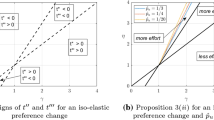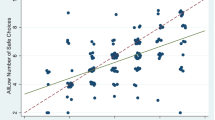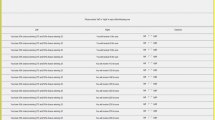Abstract
We construct a model of rational choice under risk with biased risk judgement. On its basis, we argue that sometimes, a regulator aiming at maximising social welfare should affect the environment in such a way that it becomes ‘less safe’ in common perception. More specifically, we introduce a bias into each agent’s choice of optimal risk levels: consequently, in certain environments, agents choose a behaviour that realises higher risks than intended. Individuals incur a welfare loss through this bias. We show that by deteriorating the environment, the regulator can motivate individuals to choose behaviour that is less biased, and hence realises risk levels closer to what individuals intended. We formally investigate the conditions under which such a Beneficial Safety Decrease—i.e. a deteriorating intervention that has a positive welfare effect—exists. Finally, we discuss three applications of our model.
Similar content being viewed by others
References
Arnould R., Grabowski H. (1981) Auto safety regulation: An analysis of market failure. Bell Journal of Economics 12: 27–48
Camerer C., Issacharoff S., Loewenstein G., O’Donoghue T., Rabin M. (2003) Regulation for conservatives: Behavioral economics and the case for asymmetric paternalism. University of Pennsylvania Law Review 1151(3): 1211–1254
Cottrell B. H. (1988) The effects of wide edgelines on two-lane rural roads. Transportation Research Record 1160: 35–44
De Waard D., Jessurun M., Steyvers F. J. J. M., Raggatt P. T. F., Brookhuis K. A. (1995) Effect of road layout and road environment on driving performance, drivers’ physiology and road appreciation. Ergonomics 38: 1395–1407
Evans W. N., Graham J. D. (1991) Risk reduction or risk compensation? The case of mandatory safety-belt use laws. Journal of Risk and Uncertainty 4: 61–73
Horswill M. S., Waylen A. E., Tofield M. I. (2004) Drivers’ ratings of different components of their own driving skill: A greater illusion of superiority for skills that relate to accident involvement. Journal of Applied Social Psychology 34(1): 177–195
Johansson, B. S. (1997). Trafiktränade barn löper större olycksrisk’ [Traffic-trained children run a larger accident risk]. Väg-och Transportforskningsinstitutet Aktuellt 4(June), 9.
Jorgensen F., Pedersen P. A. (2002) Drivers’ response to the installation of road lighting. An economic interpretation. Accident Analysis and Prevention 34(5): 601–608
Kallberg V.-P. (1993) Reflector post-signs of danger?. Transportation Research Record 1403: 57–66
Landsburg S. (1993) The armchair economist. Free Press, New York
Lave L. B., Weber W. W. (1970) A benefit-cost analysis of auto safety features. Applied Economics 4: 265–275
Lund A. K., Williams A. F., Zador P. (1986) High school driver education further evaluation of the DeKalb County study. Accident Analysis and Prevention 18: 349–357
Musselwhite C. (2006) Attitudes towards vehicle driving behaviour: Categorising and contextualising risk. Accident Analysis and Prevention 38(2): 324–334
O’Donoghue T., Rabin M. (2003) Studying optimal paternalism, illustrated by a model of sin taxes. American Economic Review, Papers and Proceedings 93: 186–191
Peltzman S. (1975) The effect of automobile safety regulation. Journal of Political Economy 83: 677–726
Pollack R. A. (1998) Imagined risks and cost-benefit analysis. American Economic Review 88: 376–380
Portney P. R. (1992) Trouble in Happyville. Journal of Policy Analysis and Management 11: 131–132
Rumar, K., & Marsh, D. K. (1998). Lane markings in night driving: A review of past research and of the present situation. Ann Arbor: UMTRI-98-50, University of Michigan Transportation Research Institute.
Sagberg F., Fosser S., Sætermo I. F. (1997) Investigation of behavioral adaptation to airbags and antilock brakes among taxi drivers. Accident Analysis and Prevention 29: 293–302
Salanié F., Treich N. (2009) Regulation in Happyville. Economic Journal 119: 665–679
Sjöberg L. (2000) Factors in risk perception. Risk Analysis 20(1): 1–11
Sjöberg, L., Moen, B.-E., & Rundmo, T. (2004). Explaining risk perception. An evaluation of the psychometric paradigm in risk perception research. Trondheim: Rotunde publikasjoner no. 84. Available online at www.svt.ntnu.no/psy/Torbjorn.Rundmo/Psychometric_paradigm.pdf (2009-11-16).
Slovic P. (1987) Perception of risk. Science 236: 280–285
Steyvers F. J. J. M. (1999) Increasing safety by removing visual cues—a contradiction?. In: Gale A. E., Brown I. D., Haslegrave C. M., Taylor S. P. (eds) Vision in vehicles VII. Elsevier, Amsterdam, pp 301–310
Sunstein C. R., Thaler R. H. (2003) Libertarian paternalism is not an oxymoron. University of Chicago Law Review 70(4): 1159–1202
Traynor T. L. (1993) The Peltzman hypothesis revisited: An isolated evaluation of offsetting driver behavior. Journal of Risk and Uncertainty 7: 237–247
van Driel C. J. G., Davidse R. J., van Maarseveen M. F. A. M. (2004) The effects of an edgeline on speed and lateral position: A meta-analysis. Accident Analysis and Prevention 36(4): 671–682
Viscusi W. K. (1984) The lulling effect: The impact of child-resistant packaging on aspirin and analgesic ingestions. American Economic Review 74: 324–327
Viscusi W. K. (1995) Government action, biases in risk perception, and insurance decisions. The Geneva Papers on Risk and Insurance Theory 20(1): 93–110
Winston C., Maheshri V., Mannering F. (2006) An exploration of the offset hypothesis using disaggregate data:the case of airbags and antilock brakes. Journal of Risk and Uncertainty 32: 83–99
Author information
Authors and Affiliations
Corresponding author
Rights and permissions
About this article
Cite this article
Grüne-Yanoff, T., Rosencrantz, H. Beneficial safety decreases. Theory Decis 70, 195–213 (2011). https://doi.org/10.1007/s11238-010-9235-2
Published:
Issue Date:
DOI: https://doi.org/10.1007/s11238-010-9235-2




